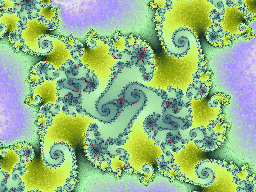
Fractint now has this amazing capability to zoom into unbelievable depths with precision up to 1600 decimal digits. So you can now look for new and unique fractal regions at previously unheard of scale. The trick is not to get carried away with just zooming in, where you can get lost in infinite whorls of self-similarity, but to carefully step from minibrot to minibrot, looking for new levels of complexity and detail. I took a shot at it and produced this image. I thought that the fine filigree structure was fascinating.
The region is in a spiral, but not too deeply and the precision is about 18 decimal digits. It is not even seriously testing the arbitrary precision math, but the full size image still managed to take about 3 weeks to compute on my 486DX/66 computer. This is primarily due to the high iteration limit and the image resolution of 1024x768 for the full-size image. It was my first attempt to achieve the dubious honour of watching fractint inform me that my image took too long to compute. I didn't quite succeed. I was about three days short of the required lapsed time, but I seriously taxed my own limits in creating it. That's a long time to wait for one image. Hat's off to those with the personal fortitude to explore deeper and wait longer.
Wes Loewer, loewer@tenet.edu the one who programmed the arbitrary precision math routines into fractint, has sent me his deepest zooming effort. It is a 1.0e1500 zoom into a self similar region at the very top of the mset in the region of (0.0, 1.0)
 The Top1500s image.
The Top1500s image.
This version is a gif87a format and I use it here as it is a much smaller file due to a better compression with a reduced palette than the original gif89a version that contains the fractint information. The two images are almost identical and the only reason to download the gif89a version would be to load it into fractint and keep zooming or to actually see fractint report an image that took 7 weeks, 2 days, 8 hours, 15 minutes, 33.50 seconds of actual running time to compute on a 486sx/25 system. It was calculated using a boundary trace mode that help reduce the calculation time. Only about 20% of the pixels in this image needed to be computed using this algorithm The fractint .par entry is:
top-mag1500 { ; a really really deep zoom Wesley Loewer
; highly self similar
; took over 1200 hours at 320x240 on a 486sx/25
reset=1920 type=mandel passes=b center-mag=0.0/1.0/1e+1500
maxiter=15000
}
Learn more about Wes's efforts in
exploring self-similarity in the M-set
in this area and view a couple of fli animations he has created.
![[NEW]](/file/29450/Internet CD.iso/web/computer/spanky~1.ca/www/fractint/new.gif)
I used Dewey Odhner's dewey@mipg.upenn.edu original parameter file
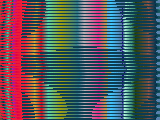 Horizontal-hold image to generate
this fractal. It caused a reasonable amount of consternation on
the sci.fractals usenet newsgroup. Noone had seen anything
quite like this before and some people thought that Fractint's
deepzooming feature was broken. This was modified slightly from
the original. It uses 1-pass mode with periodicity turned off and has
a different palette, but it should give you an idea why we were all
concerned.
Horizontal-hold image to generate
this fractal. It caused a reasonable amount of consternation on
the sci.fractals usenet newsgroup. Noone had seen anything
quite like this before and some people thought that Fractint's
deepzooming feature was broken. This was modified slightly from
the original. It uses 1-pass mode with periodicity turned off and has
a different palette, but it should give you an idea why we were all
concerned.
Bengt Månsson bengtmn@algonet.se backed out a little bit and found this
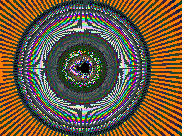 reassuring geometric structure
nearby and we all relaxed again. Another version of the horzontal-hold image
was created by Serge Moes, serge@cix.compulink.co.uk.
reassuring geometric structure
nearby and we all relaxed again. Another version of the horzontal-hold image
was created by Serge Moes, serge@cix.compulink.co.uk.
This
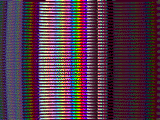 thumbnail
links to Serge's fullsize 1024x768 version done with Dewey's original
colour scheme. He says it took about 10 days on his 486DX2 computer.
thumbnail
links to Serge's fullsize 1024x768 version done with Dewey's original
colour scheme. He says it took about 10 days on his 486DX2 computer.
Kerry Mitchell, lkmitch@primenet.com created a deepzoom fractal from this area as well. I'll include the text and the parfile that he sent me along with the image.
 The zoom256.gif image.
The zoom256.gif image.
Here is my first attempt at a deepzoom fractal. It is a Mandelbrot midget on the spike (negative real axis), that was carefully chosen. If you look at the midget at -1.75, you'll see that it is associated with the number 3. That is, this midget causes the band of dwell = 3 to dip down toward the axis, and the main cardioid for this midget has periodicity = 3. In a similar fashion, the midget in this deepzoom is associated with 256. It took over 37 hours to compute on a 486DX50, at 320x240 resolution and single pass mode (although the image is symmetric).
two56 {;dwell 256 midget by Kerry Mitchell lkmitch@primenet.com
reset=1930 type=mandel passes=1
center-mag=-1.9999999999999999999999999999999999999999999999999999999999\
999999999999999999999999999999999999999999999999999999999999999999999999\
999999999999999999999988958369124178362173165279999331644308055316120970\
270840859424786314709441797847655533023252895333209618981099216864198315\
29734837424289096210971806586916814/0.0/7e+305 params=0/0 float=y
maxiter=8192 inside=0 periodicity=0
colors=CCC<14>eCegCggCg<14>_CsZCsXDs<12>EJsCKsCMs<13>CmsCosCor<14>CsS<22\
>qsnssossn<21>ssMssKsrK<14>sWCsVCrUCqTC<11>hECgCCgCC<46>cCsbCs`Cs<12>EFs\
CGsCIs<14>Cks<14>CFF cyclerange=0/255
}
Bengt Månsson has continued his deep-zooming explorations.
More
Deepzoom's with Bengt at the Tip of the Mset.
![[NEW]](/file/29450/Internet CD.iso/web/computer/spanky~1.ca/www/fractint/new.gif)
Bengt has started his explorations
in a seahorse valley of the Mset.
![[NEW]](/file/29450/Internet CD.iso/web/computer/spanky~1.ca/www/fractint/new.gif)
Here is another interesting Deepzoom image of Dewey's that has a bit
of history. This is a deepzoom image into the mandelbrot using 63 decimal
digits of precision.
![[NEW Image]](/file/29450/Internet CD.iso/web/computer/spanky~1.ca/www/fractint/dz/m-390m~1.gif)
The thumbnail leads to a 1024x768x256 image of 195 kbytes.
The maximum iteration count was set to 65535.
The calculation time to
completion was:
2413 hrs, 22 min, 56.14 seconds.
The approximate location
of the image is:
(x = -0.03905562293721000)
(y = 0.58680201260632834)
The magnification factor is 4.4x10^58
Dewey Odhner dewey@mipg.upenn.edu started this fractal and posted
the partial image on the net when it was 2/3 completed after
expending approximately 2343 hours of calculation time on a 486/33 computer.
Charles Crocker chasc@ccsnet.com picked up the image and finished it
in about 70 hrs on a Pentium 90 system and sent it on to me. This is about
a factor of 20 increase in performance. Not insignificant! It turns a
calculation that was going to take hundreds of days into something tolerable.
Both Charles and I were a little curious as to how Dewey found this minibrot. When calculation times are this long, random zooming is no longer a workable method. He must have some technique for isolating the buds. I queried him on this and here is his reply:
" I found the spidrweb minibrot by looking at areas around larger minibrots and learning to recognize where they occur, what the areas tend to look like as you look on smaller buds and closer to the tip of the bud. I tried to find the largest minibrot within that distance of the bud tip. "
Frank Gentges has contributed a few images and some documentation on
his
deepzooming explorations into the Horizontal Hold area.
![[NEW]](/file/29450/Internet CD.iso/web/computer/spanky~1.ca/www/fractint/new.gif)
These and other more ambitious deepzooms can be found in this collection of email's and parfiles gleaned from the sci.fractals usenet newsgroup.
Minoru Morikawa morikawa@fukui-nct.ac.jp in Japan, has provided three small deepzoom images into the tip of the mset.
 The m1280cm.gif image.
The m1280cm.gif image.
m1280cm.gif : small M with period 1280. mag 10^1539. preview mode.
 The m1280pa.gif image.
The m1280pa.gif image.
m1280pa.gif : the right side of the above small M. mag 10^1542. preview mode.
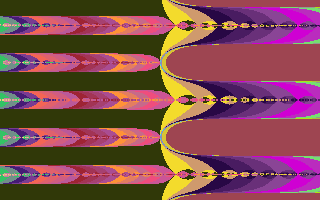 The m320paf.gif image.
The m320paf.gif image.
m320paf.gif : the right side of small M with period 320. mag 10^386. 320*200 mode. You can also view more detailed information on Fractint's Deepzooming by looking at the online documentation.